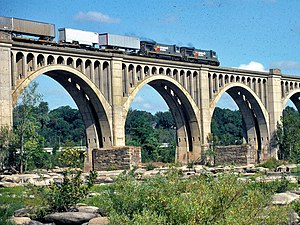TheSeaboard System Railroad, Inc.(reporting markSBD) was aUSClass I railroadthat operated from 1982 to 1986.
 | |
 A Seaboard freight train crosses theJames RiveratRichmond, Virginia,in October 1985. | |
| Overview | |
|---|---|
| Headquarters | Seaboard System Railroad Building,500 Water Street,Jacksonville, Florida |
| Reporting mark | SBD |
| Locale | Southeastern United States |
| Dates of operation | December 29, 1982–July 1, 1986 |
| Predecessors | Seaboard Coast Line Louisville and Nashville Clinchfield Railroad Georgia Railroad Atlanta and West Point Railroad Western Railway of Alabama |
| Successor | CSX Transportation |
Since the late 1960s,Seaboard Coast Line Industrieshad operated theSeaboard Coast Lineand its sister railroads—notably theLouisville & NashvilleandClinchfield—as the "Family Lines System". In 1980, SCLI merged with theChessie Systemto create the holding companyCSX Corporation;two years later, CSX merged the Family Lines railroads to create the Seaboard System Railroad.
In 1986, Seaboard renamed itselfCSX Transportation,which absorbed the Chessie System's two major railroads the following year.
History
editThe Seaboard System's roots trace back to SCL Industries, a holding company created in 1968 that combined the Seaboard Coast Line's subsidiary railroads into one entity. In 1969, SCL was renamedSeaboard Coast Line Industries,which was known as theFamily Lines Systemfrom 1972-1982, to better compete with theSouthern Railway System.This entity adopted its own logo and colors, but each railroad maintained its own identity. Over time, this caused confusion among customers. In comparison to the neighboringChessie System,which had four railroads, the Family Lines had six railroads.[1]In 1971 SCL bought out the remaining shares and made the Louisville & Nashville a subsidiary.
On November 1, 1980, Seaboard Coast Line Industries and Chessie System merged under the holding companyCSX Corporation.Over the following seven years, the Chessie and Seaboard's various railroads were gradually merged into one.
The first step came on December 29, 1982, when theSeaboard Coast LineandLouisville & Nashville(under the Family Lines entity) were merged to form the Seaboard System Railroad, Inc.[1][2]
Considered as a "temporary railroad", the Seaboard System quickly began to merge the smaller railroads that were owned under the Family Lines System entity. This included theGeorgia Railroadand theClinchfield Railroad(1983),South Carolina Pacific Railway(April 30, 1984), Louisville, Henderson & St. Louis Railway (July 1984), Gainesville Midland (1985),Atlanta & West Point Railroad(June 1986) and the Columbia, Newberry & Laurens (June 1986). These mergers simplified equipment and management alongside the Chessie System railroads (Chesapeake & Ohio,Baltimore & Ohio,Western Maryland).
The Seaboard System renamed itselfCSX Transportationon July 1, 1986. On April 30, 1987, the Baltimore & Ohio Railroad was merged into the Chesapeake & Ohio. Finally, on August 31, 1987, the Chesapeake & Ohio (still under the Chessie System entity for corporate reasons) was merged into CSX Transportation. All the major railroads under CSX Corporation were now one company.[3](The Western Railway of Alabama would remain anoperating subsidiaryuntil December 2002, when it was finally merged into CSX.[4])
Equipment colors and painting
editAfter creation of the Family Lines name, SCLI begin painting locomotives in a standardized paint scheme. When the Seaboard System came into being, the new scheme retained the grey, red, and yellow colors were of the Family Lines scheme. The new Seaboard System also had a new logo featuring a coupled variation font ofITCEras Demi.The first locomotive to be decorated with the new Seaboard System paint scheme was UcetaGP16#4802 in October 1982. Because the merger did not occur until December, locomotives after October 1982 were to receive the Seaboard System paint scheme with the existing railroad's reporting marks applied.[1][3]
When the merger officially took effect on January 1, 1983, all former reporting marks were to be either removed or patched with SBD initials. Shortly before taking delivery of the L&N specifiedEMD SD50's, Seaboard adopted aSwis721[5]type font for reporting marks and numbers, instead of the customizedSeaboard Coast Linelettering seen on pre-1983 repaints. To simplify its locomotive roster and meet Chessie System specifications, Seaboard introduced a numbering system that partially became meshed within the Chessie System locomotive fleet, and removed any existingMars LightsorGyralightsfrom locomotives. Any new locomotives purchased by Seaboard would be built to meet Chessie specifications; of which only three,EMD SD50,EMD MP15TandGE B36-7,were ordered.
Heritage Units
editIn June 2023,GE ES44AHunit #1982 entered service, being repaired and repainted at CSX shops inWaycross,GAwith a CSX blue and yellow color scheme on the front (nose) and cab of the locomotive and throughout the rest of the locomotive, the classic grey Seaboard System scheme. It was numbered #1982 in homage to the year the Seaboard System was created.[6][7]A second heritage unit featuring The Family Lines System, a GE Evolution Series GE ES44AH unit #1972 entered service in March 2024.[8]
Operating divisions
editThis section lists the operating divisions of the Seaboard System as of January 1, 1985:[9]
References
edit- ^abcSolomon, Brian (2005).CSX.MBI Publishing Company. pp. 63–67.ISBN0-7603-1796-8.
- ^Griffin, William (2004).Seaboard Coast Line & Family Lines.TLC Publishing. pp. 124–136.ISBN0-9766201-0-3.
- ^abMoody's Transportation Manual,1992, pp. xxii-xxiv, 421-428, 451
- ^Surface Transportation Board,CSX Transportation, Inc.--Corporate Family Merger Exemption--The Western Railway of Alabama,December 26, 2002
- ^"1:36 Drawings - Text and Logos".Archived fromthe originalon 2012-07-09.Retrieved2012-06-27.
- ^"CSX - CSX Honors Seaboard System Railroad Heritage with New Locomotive Paint Design".csx.Retrieved2024-03-14.
- ^"CSX's Seaboard System heritage locomotive makes its debut".Trains.2023-06-30.Retrieved2024-03-14.
- ^"CSX - CSX Unveils Family Lines System Heritage Locomotive".csx.Retrieved2024-03-14.
- ^Seaboard System Railroad: List of Stations and Yards.Office of General Manager: Terminal Station Manager. January 1, 1985.